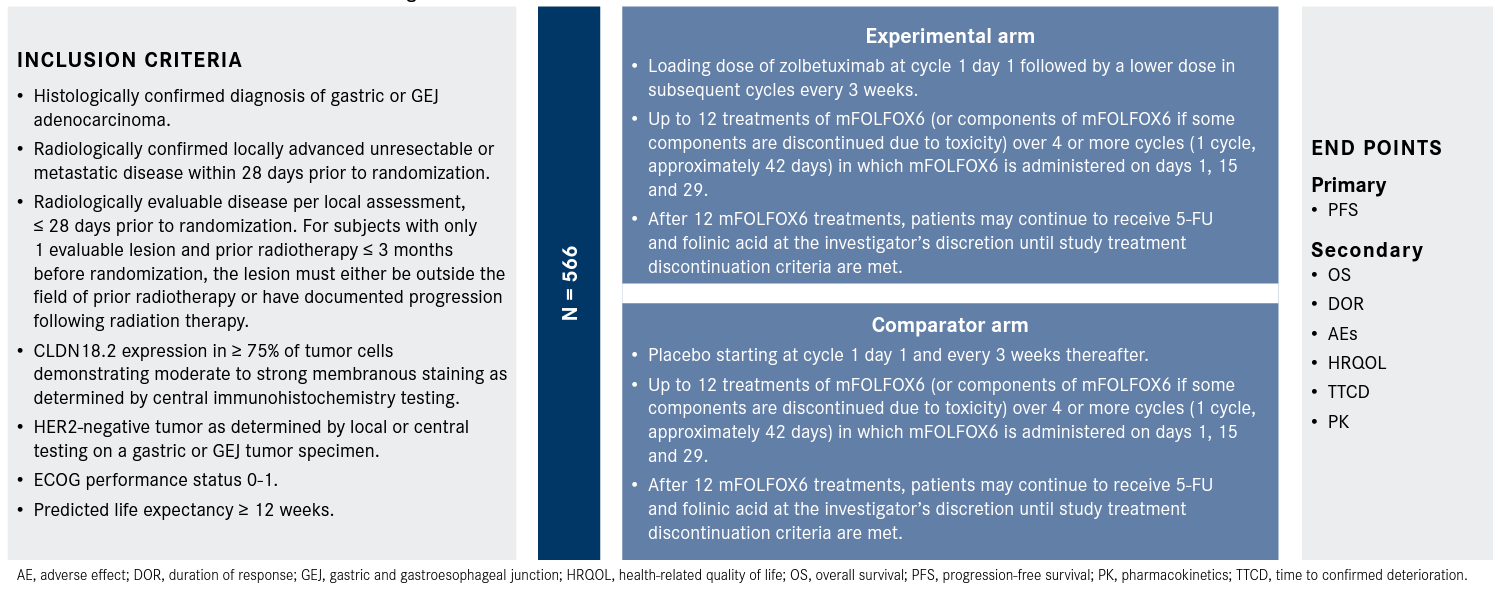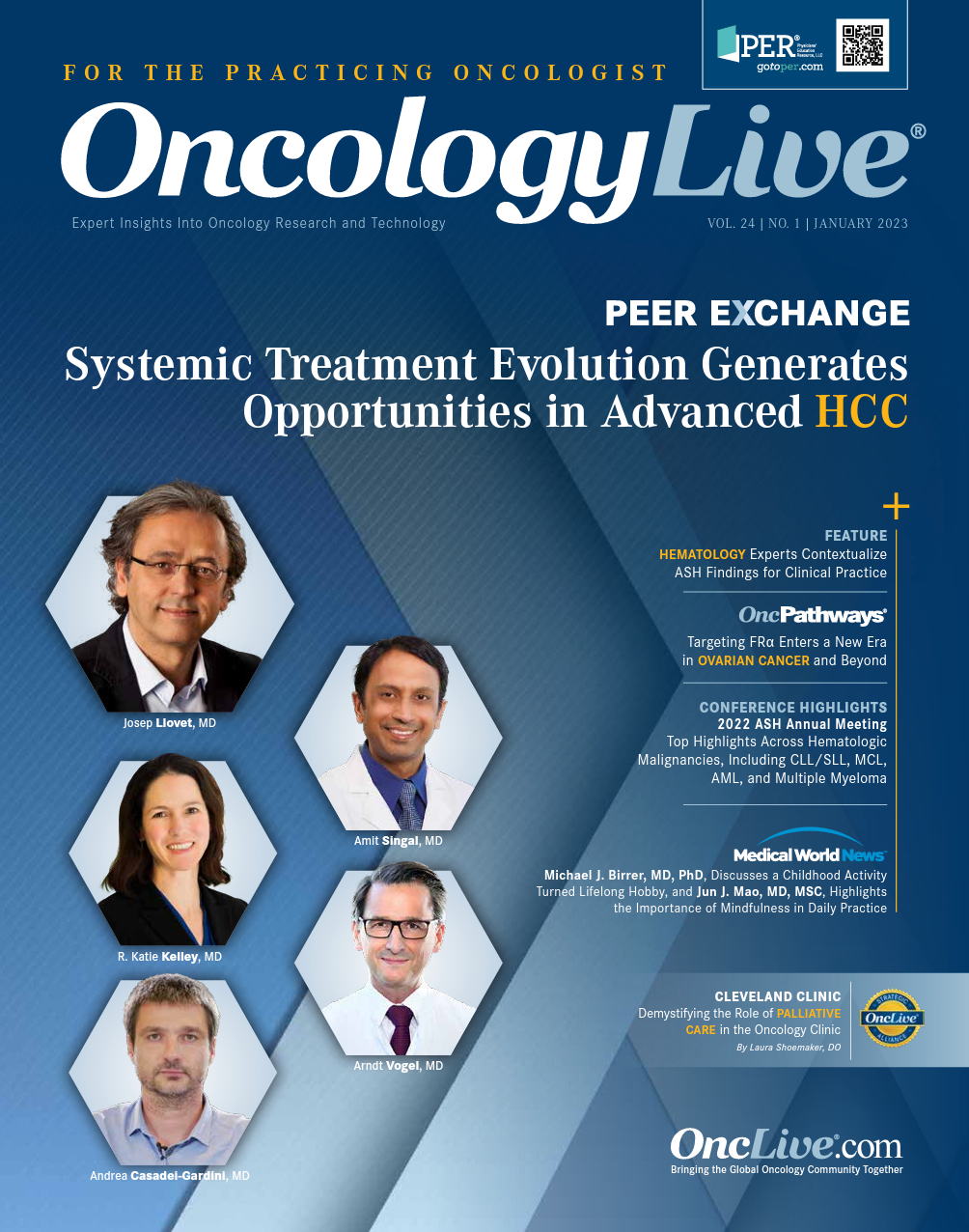Publication
Article
Zolbetuximab Aims to Add First-of-Its-Kind Approach to GEJ Cancer Treatment Paradigm
Author(s):
The biomarker claudin 18.2 has recently shown promise as an intriguing new target in the gastroesophageal junction adenocarcinoma space.
Sam Klempner, MD

Despite continued advances in the treatment landscape of gastric and gastroesophageal junction (GEJ) adenocarcinoma, patients who are diagnosed with the disease often still present at an advanced disease stage and have a poor prognosis. This unmet need underscores the necessity of new and more effective biomarkers and treatment targets. The biomarker claudin 18.2 (CLDN18.2) has recently shown promise as an intriguing new target in the GEJ space.
“CLDN18.2 is an emerging biomarker that may become standard depending on the data that we see in the near future,” Sam Klempner, MD, a medical oncologist at Massachusetts General Hospital in Boston, said in an interview with OncologyLive®. “It is a cell surface protein that’s involved in tight junctions. It’s normally oriented towards the base of the epithelial cells, then in tumorigenesis this often becomes re-polarized and exposed more on the luminal surface, [making it] potentially more accessible to drugs.”
Zolbetuximab is a first-in-class, investigational igG1 monoclonal antibody that targets CLDN18.2. Once it binds to the protein, zolbetuximab mediates tumor cell death via antibody-dependent cellular cytotoxicity and complement-dependent cytotoxicity. The agent has previously displayed efficacy and tolerability as a monotherapy among patients with CLDN18.2-positive GEJ that has been treated with multiple prior lines of therapy.1
Building on the results achieved with zolbetuximab monotherapy, investigators initiated the phase 2 FAST trial (NCT01630083). In FAST, study authors aimed to compare the safety and efficacy of zolbetuximab in combination with epirubicin, oxaliplatin, and capecitabine (EOX) with that of EOX alone for the first-line treatment of patients with CLDN18.2-positive advanced GEJ adenocarcinoma.
FAST enrolled adult patients with disease that displayed a minimum of 40% CLDN18.2-positive tumor cells. The primary end point was progression-free survival (PFS), and overall survival (OS) represented a key secondary end point.
After enrollment, patients were randomly assigned 1:1 to receive either EOX every 3 weeks (arm 1; n = 84) or EOX every 3 weeks plus zolbetuximab at a loading dose of 800 mg/m2 followed by 600 mg/m2 every 3 weeks (arm 2, n = 77). Following initiation, investigators added a third arm (n = 85) that received EOX plus zolbetuximab 1000 mg/m2 every 3 weeks.
Findings from the trial showed that patients in arm 2 achieved a median PFS of 7.5 months (95% CI, 5.6-11.3) compared with 5.3 months (95% CI, 4.1-7.1) in arm 1 (HR, 0.44; 95% CI, 0.29-0.67; P < .0005). Median OS was also superior in arm 2 vs arm 1, at 13.0 months (95% CI, 9.7-18.7) and 8.3 months (95% CI, 6.9-10.2), respectively (HR, 0.55; 95% CI, 0.39-0.77; P < 0.0005).
In terms of safety, investigators noted that zolbetuximab displayed an acceptable tolerability profile with manageable adverse effects (AEs). Commonly occurring AEs of any grade in arm 2 included nausea (81.8%), vomiting (67.5%), and anemia (45.5%). Comparatively in arm 1, AEs of any grade included nausea (76.2%), vomiting (54.8%), and diarrhea (36.9%).
Patients in both arms experienced AEs potentially associated with hypersensitivity reactions at a rate of 14.3%. Serious AEs were reported in 32.1% and 24.7% of patients in arm 1 and arm 2, respectively. Fatal AEs occurred in 17.9% vs 10.4%, respectively.
Additional data showed that patients with moderate to strong CLDN18.2 expression (≥ 70% of tumor cells) experienced an even more pronounced PFS and OS benefit when zolbetuximab was added to EOX. Patients with at least 70% CLDN18.2positive tumor cells in arm 2 (n = 57) experienced a median PFS of 9.0 months compared with 5.7 months among the 59-patients who met the criteria in arm 1 (HR, 0.38; 95% CI, 0.23-0.62; P < .0005). The median OS for these patients was 16.5 months vs 8.9 months, respectively (HR, 0.50; 95% CI, 0.330.74; P < .0005). Notably, in patients with 40% to 69% of tumor cells displaying CLDN18.2-positivity, there was not a significant difference in terms of PFS or OS between the 2 arms.
“Importantly, and consistent with other biomarkers, we learned a lot about the cutoffs, the optimal patient selection, and who’s really benefiting from these drugs,” Zev A. Wainberg, MD, a professor of medicine and the codirector of the University of California Los Angeles GI Oncology Program, said in an interview with OncologyLive®. “It became relatively clear from looking at the FAST trial that if you look at the patients who had greater than 70% staining for CLDN18.2, there was a substantial magnitude of benefit improvement. It became very exciting to see such a dramatic magnitude of benefit in a biomarker-selected population. Immediately there was a lot of enthusiasm to move this into validating and confirmatory phase 3 trials to see if this was real and would improve the survival and PFS of our patients.”
Zolbetuximab Shows Promise in Combination With Multiple Chemotherapy Regimens
In light of the positive findings from the FAST trial, the safety and efficacy of zolbetuximab plus chemotherapy is now under evaluation in multiple phase 3 clinical trials.
“The SPOTLIGHT trial [NCT03504397] and the somewhat parallel GLOW [NCT03653507] trial are 2 global randomized phase 3 trials that are trying to confirm the results of the phase 2 [study] using 2 different chemotherapy backbones,” Klempner said.
In the phase 3 SPOTLIGHT trial (NCT03504397), investigators are evaluating the safety and efficacy of zolbetuximab plus oxaliplatin, leucovorin, and fluorouracil (mFOLFOX6) compared with placebo plus mFOLFOX6 in patients with CLDN18.2-positive, HER2-negative locally advanced or metastatic GEJ adenocarcinoma.
The double-blind trial will randomly assign approximately 566 patients to 1 of the 2 treatment arms. In the investigational arm, patients will receive a loading dose of zolbetuximab on day 1 of cycle 1 followed by a lower dose in subsequent cycles every 3 weeks. Zolbetuximab will be given intravenously over a minimum of 2 hours (Figure2).
Figure. SPOTLIGHT Phase 3 Trial Design2

Patients will receive mFOLFOX6 for up to 12 treatments over 4 or more 42-day cycles. The chemotherapy regimen will be administered on days 1, 15, and 29. Patients can continue treatment with fluorouracil and folinic acid following the completion of the 12 mFOLFOX6 treatments at the clinician’s discretion until study treatment discontinuation criteria are met.
The primary end point is PFS. Secondary end points consist of OS, ORR, DOR, and safety and tolerability. The trial is active but is no longer enrolling any new patients.
On November 17, 2022, Astellas Pharma, the manufacturer of zolbetuximab, announced the topline findings from SPOTLIGHT. Investigators noted that the study had met its primary end point of PFS; zolbetuximab plus mFOLFOX6 displayed a statistically significant improvement in terms of PFS compared with placebo plus mFOLFOX6. The trial enrolled the targeted amount of 566 patients with CLDN18.2-positive, HER2-negative, locally advanced unresectable or metastatic gastric or GEJ adenocarcinoma.3
Additionally, the secondary end point of OS was also met, as the zolbetuximab-containing combination again improved survival in a statistically significant manner compared with placebo plus chemotherapy. Commonly occurring TEAEs in the zolbetuximab arm included nausea, vomiting, and decreased appetite. More in depth results will be presented at a future scientific meeting and be submitted for publication, study authors wrote in conclusion.
“We have to see the full dataset to know the extent of the improvement,” Wainberg said. “Beyond statistical significance, you want to see some degree of clinical significance. But, on the outset, it means that most likely we have got a positive study–which usually implies an ultimate FDA approval. That means we’ll have a new drug at our disposal to use in metastatic HER2-negative gastric cancer. How it will be used in the real world has a lot to do with some of the data that we’re waiting to see, [such as] toxicity data, overlapping biomarkers of interest, and determining whether [zolbetuximab is] the right drug versus another drug.”
Similarly, in the GLOW trial, zolbetuximab is being administered in combination with capecitabine and oxaliplatin (CAPOX). The safety and efficacy of the combination is being compared with that of placebo plus CAPOX in patients with CLDN18.2-positive, HER2-negative unresectable or metastatic GEJ adenocarcinoma.4
The multicenter, double-blind study is aiming to enroll approximately 507 patients. Patients will be randomly assigned to receive either zolbetuximab plus CAPOX or placebo plus CAPOX. On the investigational arm, zolbetuximab patients will be given a loading dose of zolbetuximab at Cycle 1 Day 1 followed by a lower dose in subsequent cycles every 3 weeks, administered as an intravenous infusion lasting at least 2 hours.
CAPOX will be administered for a total of 8 treatments, with each cycle being defined 3 weeks, or until disease progression. Oxaliplatin will be given as a 2-hour intravenous infusion on day 1 of each cycle; capecitabine will be administered orally twice daily on days 1 through 14. Patients may continue to receive the same dosing schedule of capecitabine after the maximum of 8 oxaliplatin cycles is reached, until they meet the criteria for study treatment discontinuation.
On the control arm, patients be treated with CAPOX according to the same dosing schedule as those on the zolbetuximab arm, with placebo replacing the monoclonal antibody. The primary end point of the trial is PFS. Secondary end points include OS, time to conformed deterioration, ORR, and DOR. The trial is currently active but not recruiting new patients.
On December 15, 2022, Astellas announced positive topline findings from GLOW. Early results from the trial showed that the study met its primary end point, as zolbetuximab plus CAPOX showed a statistically significant improvement in PFS compared with placebo plus CAPOX. The key secondary end point of OS was also met, as the combination again displayed statistical significance over placebo plus chemotherapy.5
In terms of safety, the most common TEAEs observed with the zolbetuximab-containing regimen were nausea and vomiting. Detailed findings will be presented at a scientific meeting and submitted for publication.
References
- Sahin U, Türeci Ö, Manikhas G, et al. FAST: a randomised phase II study of zolbetuximab (IMAB362) plus EOX versus EOX alone for f irst-line treatment of advanced CLDN18.2-positive gastric and gastro-oesophageal adenocarcinoma. Ann Oncol. 2021;32(5):609-619. doi:10.1016/j.annonc.2021.02.005
- A phase 3 efficacy, safety and tolerability study of zolbetuximab (experimental drug) plus mFOLFOX6 chemotherapy compared to placebo plus mFOLFOX6 as treatment for gastric and gastroesophageal junction (GEJ) cancer (Spotlight). ClinicalTrials.gov. Updated December 6, 2022. Accessed December 19, 2022. https://clinicaltrials.gov/ct2/show/NCT03504397
- Astellas announces zolbetuximab meets primary endpoint in phase 3 SPOTLIGHT trial as first-line treatment in claudin 18.2 positive, HER2-negative locally advanced or metastatic gastric and gastroesophageal junction (GEJ) cancers. News release. Astellas. November 16, 2022. Accessed December 19, 2022. prn.to/3FDwJF5
- A study of zolbetuximab (IMAB362) plus CAPOX compared with placebo plus CAPOX as first-line treatment of subjects with claudin (CLDN) 18.2-positive, HER2-negative, locally advanced unresectable or metastatic gastric or gastroesophageal junction (GEJ) adenocarcinoma (GLOW). ClinicalTrials.gov. Updated December 14, 2022. Accessed December 19, 2022. https://clinicaltrials.gov/ct2/show/ NCT03653507
- Astellas announces zolbetuximab meets primary endpoint in phase 3 GLOW Trial as first-Line treatment in claudin 18.2 positive, HER2-negative locally advanced unresectable or metastatic gastric and gastroesophageal junction (GEJ) cancers. News release. Astellas. December 15, 2022. Accessed December 19, 2022. prn.to/3WskVfF









